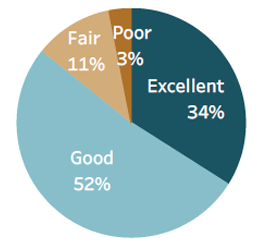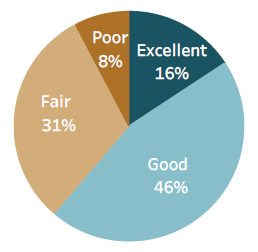2021 National Community Survey
See press release 'Despite Challenges of the COVID-19 Health Crisis, Montgomery County Residents Continue to Give County High Marks for Quality of Life'.
 The National Community Survey™ (The NCS™) report is about the “livability” of Montgomery County. A livable community is a place that is not simply habitable, but that is desirable. It is not only where people do live, but where they want to live. The survey was developed by the experts from National Research Center at Polco.
The National Community Survey™ (The NCS™) report is about the “livability” of Montgomery County. A livable community is a place that is not simply habitable, but that is desirable. It is not only where people do live, but where they want to live. The survey was developed by the experts from National Research Center at Polco.
Great communities are partnerships of the government, private sector, community-based organizations and residents, all geographically connected. The NCS captures residents’ opinions considering ten central facets of a community:
The report provides the opinions of a representative sample of 565 residents of Montgomery County collected from November 29, 2021 to January 17, 2022. The margin of error around any reported percentage is 4% for all respondents and the response rate for the 2021 survey was 12%. Survey results were weighted so that the demographic profile of respondents was representative of the demographic profile of adults in Montgomery County.
Summary of Report
 Measuring community livability starts with assessing the quality of life of those who live there, and ensuring that the community is attractive, accessible, and welcoming to all.
Measuring community livability starts with assessing the quality of life of those who live there, and ensuring that the community is attractive, accessible, and welcoming to all.
 Strong local governments produce results that meet the needs of residents while making the best use of available resources, and are responsive to the present and future needs of the community as a whole.
Strong local governments produce results that meet the needs of residents while making the best use of available resources, and are responsive to the present and future needs of the community as a whole.
 Local governments work together with private and nonprofit businesses, and with the community at large, to foster sustainable growth, create jobs, and promote a thriving local economy.
Local governments work together with private and nonprofit businesses, and with the community at large, to foster sustainable growth, create jobs, and promote a thriving local economy.
 The ease with which residents can move about their communities, whether for commuting, leisure, or recreation, plays a major role in the quality of life for all who live, work, and play in the community.
The ease with which residents can move about their communities, whether for commuting, leisure, or recreation, plays a major role in the quality of life for all who live, work, and play in the community.
 A well-designed community enhances the quality of life for its residents by encouraging smart land use and zoning, ensuring that affordable housing is accessible to all, and providing access to parks and other green spaces.
A well-designed community enhances the quality of life for its residents by encouraging smart land use and zoning, ensuring that affordable housing is accessible to all, and providing access to parks and other green spaces.
 Services such as water, gas, electricity, and internet access play a vital role in ensuring the physical and economic health and well-being of the communities they serve.
Services such as water, gas, electricity, and internet access play a vital role in ensuring the physical and economic health and well-being of the communities they serve.
 Public safety is often the most important task facing local governments. All residents should feel safe and secure in their neighborhoods and in the greater community, and providing robust safety-related services is essential to residents' quality of life.
Public safety is often the most important task facing local governments. All residents should feel safe and secure in their neighborhoods and in the greater community, and providing robust safety-related services is essential to residents' quality of life.
 The natural environment plays a vital role in the health and well-being of residents. The natural spaces in which residents live and experience their communities has a direct and profound effect on quality of life.
The natural environment plays a vital role in the health and well-being of residents. The natural spaces in which residents live and experience their communities has a direct and profound effect on quality of life.
 "There are no communities that pride themselves on their quality of life, promote themselves as a desirable location for businesses to relocate, or maintain that they are environmental stewards of their natural resources, without such communities having a robust, active system of parks and recreation programs for public use and enjoyment." - National Recreation and Park Association
"There are no communities that pride themselves on their quality of life, promote themselves as a desirable location for businesses to relocate, or maintain that they are environmental stewards of their natural resources, without such communities having a robust, active system of parks and recreation programs for public use and enjoyment." - National Recreation and Park Association
 The characteristics of and amenities available in the communities in which people live has a direct impact on the health and wellness of residents, and thus, on their quality of life overall.
The characteristics of and amenities available in the communities in which people live has a direct impact on the health and wellness of residents, and thus, on their quality of life overall.
 Participation in the arts, in educational opportunities, and in cultural activities is linked to increased civic engagement, greater social tolerance, and enhanced enjoyment of the local community.
Participation in the arts, in educational opportunities, and in cultural activities is linked to increased civic engagement, greater social tolerance, and enhanced enjoyment of the local community.
 Inclusivity refers to a cultural and environmental feeling of belonging; residents who feel invited to participate within their communities feel more included, involved, and engaged than those who do not.
Inclusivity refers to a cultural and environmental feeling of belonging; residents who feel invited to participate within their communities feel more included, involved, and engaged than those who do not.
Conclusions
Safety is a priority area for residents, with some ratings decreasing over time.
Residents gave relatively lower quality ratings to the overall feeling of safety in the County (77% excellent or good) and relatively higher ratings of importance (90% essential or very important), suggesting that the facet of Safety is a potential area of focus for Montgomery County in the coming years. Ratings within this facet tended to be similar to those given in other communities across the nation. Virtually all residents felt safe in their neighborhood during the day, and about 9 in 10 felt safe in the downtown/commercial area during the day. About 8 in 10 reported feeling safe from violent crime, while three-quarters felt safe from property crime. Safety-related services also tended to receive high marks: about 9 in 10 survey respondents positively rated fire services, ambulance/EMS, and fire prevention and education, while about three-quarters were pleased with Police/Sheriff services and animal control. About two-thirds gave favorable scores to crime prevention and emergency preparedness. Ratings declined from 2019 to 2021 for overall feeling of safety in the County, crime prevention, and police services, while the evaluation for animal control improved over time. The County also included several custom questions related to Safety on the 2021 survey. When asked about specific focus areas in Montgomery County and whether they had gotten better, worse, or stayed the same in the past two years, about 45% of residents reported that they thought crime had gotten somewhat worse or much worse, with another 4 in 10 indicating that they thought it had stayed the same. Only 15% of respondents felt that crime had gotten better in recent years. Thinking about their interactions with the Montgomery County Police Department in the past two years, about one-quarter had interacted with a MCPD employee in person or over the phone, while virtually none had done so online. About 9 in 10 of those who had interacted with a MCPD employee agreed that the employee had treated them fairly, and roughly 8 in 10 gave excellent or good ratings to the employee’s professionalism, approachability, and responsiveness.The economy remains a positive feature of Montgomery County, though affordability is an issue.
About 8 in 10 survey respondents gave favorable ratings to Montgomery County as a place to work, the overall quality and variety of business and service establishments, and shopping opportunities, while roughly three-quarters awarded high marks to the overall economic health of the County, the County as a place to visit, vibrant downtown/commercial area, and employment opportunities. These ratings were similar to or higher than the national benchmark comparisons, and ratings for employment opportunities and the overall quality of business and service establishments in Montgomery County improved from 2019 to 2021. However, only about 2 in 10 residents positively rated the cost of living in Montgomery County, which was lower than average. Further, when asked about focus areas in the County and whether they had improved, declined or stayed the same, slightly more than half of residents felt that affordable housing had gotten somewhat worse or much worse in the past two years, and another 3 in 10 felt it had stayed the same. Residents had a somewhat more positive outlook regarding job growth and business growth, however: about 6 in 10 thought that both had either gotten somewhat better or stayed about the same in the past two years, which is especially notable given the economic impacts of the COVID-19 pandemic during that time.
Education, Arts, and Culture are also praised by residents in the community.
Ratings in the facet of Education, Arts, and Culture also tended to be higher than or similar to the national benchmarks. About 9 in 10 residents gave positive ratings to public library services and 8 in 10 gave high scores to overall opportunities for education, culture, and the arts and K-12 education. At least 7 in 10 favorably rated adult educational opportunities, community support for the arts, opportunities to attend cultural/arts/music activities, and opportunities to attend special events and festivals. These ratings were stable from 2019 to 2021. Ratings related to the public school system in Montgomery County tended to be more mixed. Thinking about County focus areas and whether they have gotten better, worse, or stayed the same in the past two years, about one-third of respondents rated public schools (K-12) as somewhat worse or much worse than two years ago, and another 4 in 10 felt they had stayed about the same. When asked to rate various aspects of Montgomery County K-12 public schools, respondents gave the most positive ratings to the diversity of race/ethnicity of the student body (80% excellent or good), the accessibility of teachers and administrators (73%), overall quality of education (73%), and school facilities (67%); they were least likely to give positive marks to class size (46%), teacher/student ratio (46%) or the food/cafeterias (38%).


